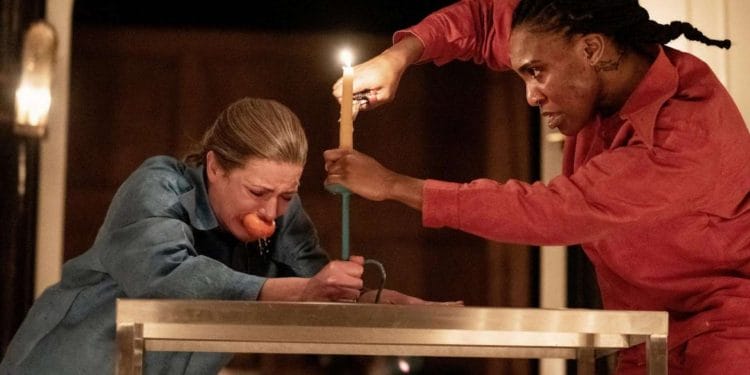 Depending on the source, the list of shows never to revive is long and arduous to monitor, especially as the world shrinks, our knowledge of it deepens, and certain narratives prove to be exorbitant, unnecessary, or plain grotesque. Surely our largely empathetic and judicious sensibilities are a far shout from the vigilante justices of violence, lust, and revenge which rule the world of the play which, for better or for worse, perches at the very top of this list: Shakespeare’s most graphic and bloody tragedy, Titus Andronicus.
Depending on the source, the list of shows never to revive is long and arduous to monitor, especially as the world shrinks, our knowledge of it deepens, and certain narratives prove to be exorbitant, unnecessary, or plain grotesque. Surely our largely empathetic and judicious sensibilities are a far shout from the vigilante justices of violence, lust, and revenge which rule the world of the play which, for better or for worse, perches at the very top of this list: Shakespeare’s most graphic and bloody tragedy, Titus Andronicus.
Among his least-taught plays (and for very good reason should the censors be questioned), Titus Andronicus unspools a painful, winding tale of grief, revenge, and tragedy that leaves few unharmed. Rome celebrates victory in the wake of a treacherous war with the Goths. After the death of its Emperor, Rome is in desperate need of a figurehead and despite the boyish efforts of his heirs Saturninus and Bassianus to prove themselves worthy of the task, the people’s favourite remains newly-lauded military general Titus Andronicus.
However, among Rome’s spoils of war is the beautiful yet crafty Tamora, defeated Queen of the Goths, who quickly rises to power after marrying Rome’s new emperor Saturninus and plans to revenge herself on Titus Andronicus, who cruelly sacrificed her eldest son Alarbus to the gods upon returning to Rome. With the help of her lover Aaron, Tamora plots the execution of Titus’ two sons by falsely incriminating them for the murder of Bassianus, actually committed by her own two sons Chiron and Demetrius along with the rape and mutilation of Titus’ daughter Lavinia. Her tricks are eventually exposed, but only after they are committed and vengeance is fought with vengeance. Titus captures her two sons, bakes them into a pie, then serves them to Tamora before stabbing and killing her. He then mercy-kills Lavinia to avenge her shame, is himself killed by Saturninus who in turn is killed by Lucius, the eldest remaining son of Titus. There are also countless victims caught in the crossfire throughout the show, from nurses to clowns and even a fly.
How then, has Jude Christian’s production managed to restage such a macabre bacchanal of torture without so much as a drop of blood? Perhaps led by a notion which critics and academics have long been debating: that the play was in fact written as a parody of the revenge plays popular throughout the 1500s. Christian manages to interrogate the show’s grisly tone for humour while paying her respects to the harrowing moments which deserve and require them.
Technically, while retaining all the tragedy of the original, plus extra heart, the production cleverly sidesteps the relentless gore of the text by introducing a clever and haunting motif. As characters enter the stage, they cut a candle by its wick from a pulley drawn across the stage. Their candle is lit and rarely leaves their side until, whether by sword or by oven, they die and their flame is extinguished by their killer. They then carry on toward the other side of the pulley and drive it down towards the ground, in the process submerging a set of incomplete candles into a vat of hot wax and creating new candles to burn, new flames to extinguish. This audacious design perfectly manifests the production’s ambitious yet reverent reading of the text and drives at something deeper in its haze of sadism and barbarity. It also beautifully lends itself towards a slapstick approach to enacting the deaths in the play. Candles are snapped in half, hulled of their wicks, hacked at with meat cleavers, torched by butane lighters, stuffed into meat grinders, liquified in kitchen blenders, and more! What you end up with is something verging on the modern black comedy; a social satire with moments of genuine clarity; or, as our musical prologue warns us: “torture porn, but more artistic.”
Indeed, before the first act even commences, we are greeted by a lively song and dance encouraging the schadenfreude that doubtlessly brought us there. This self-awareness and irreverence is what drives the natural humour exhumed from the script. Integral to Christian’s interpretation is the passionate abandon of her all-female cast. While the comic performances of Lucy McCormick as the contemptible and twitty Saturninus or Beau Holland as the show’s host of prematurely-killed-off secondary characters surely lead the charge in Christian’s satirical reinterpretation, other members of the cast pay homage to the show’s roots in tragedy. Katy Stephens’ Titus Andronicus is mournful and tender while Georgia-Mae Myers’ Lavinia is anguished and distressingly true to form: she is tragic to the bone. It is through these contrasts that Jude Christian’s Titus Andronicus triumphs. It is at once gruesome and joyous and vile and farcical and despite all the show’s detestable deeds, there remains something glimmering and hopeful to take away from this production.
Titus Andronicus is playing at the the Globe Theatre’s Sam Wanamaker Playhouse in London until the 15th of April. Tickets are available for purchase here.

















